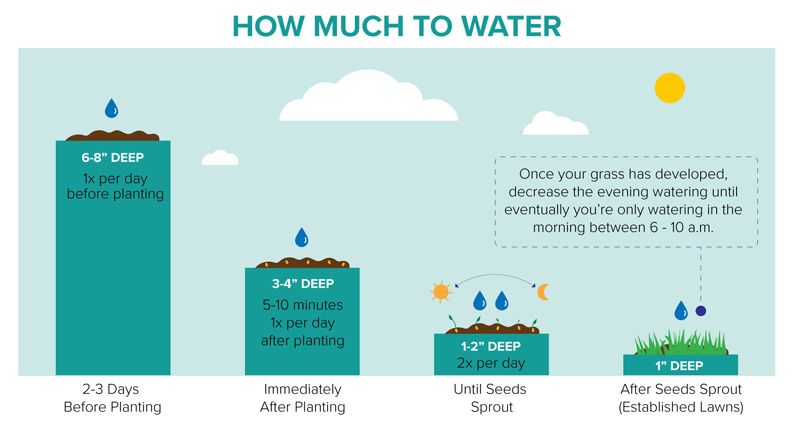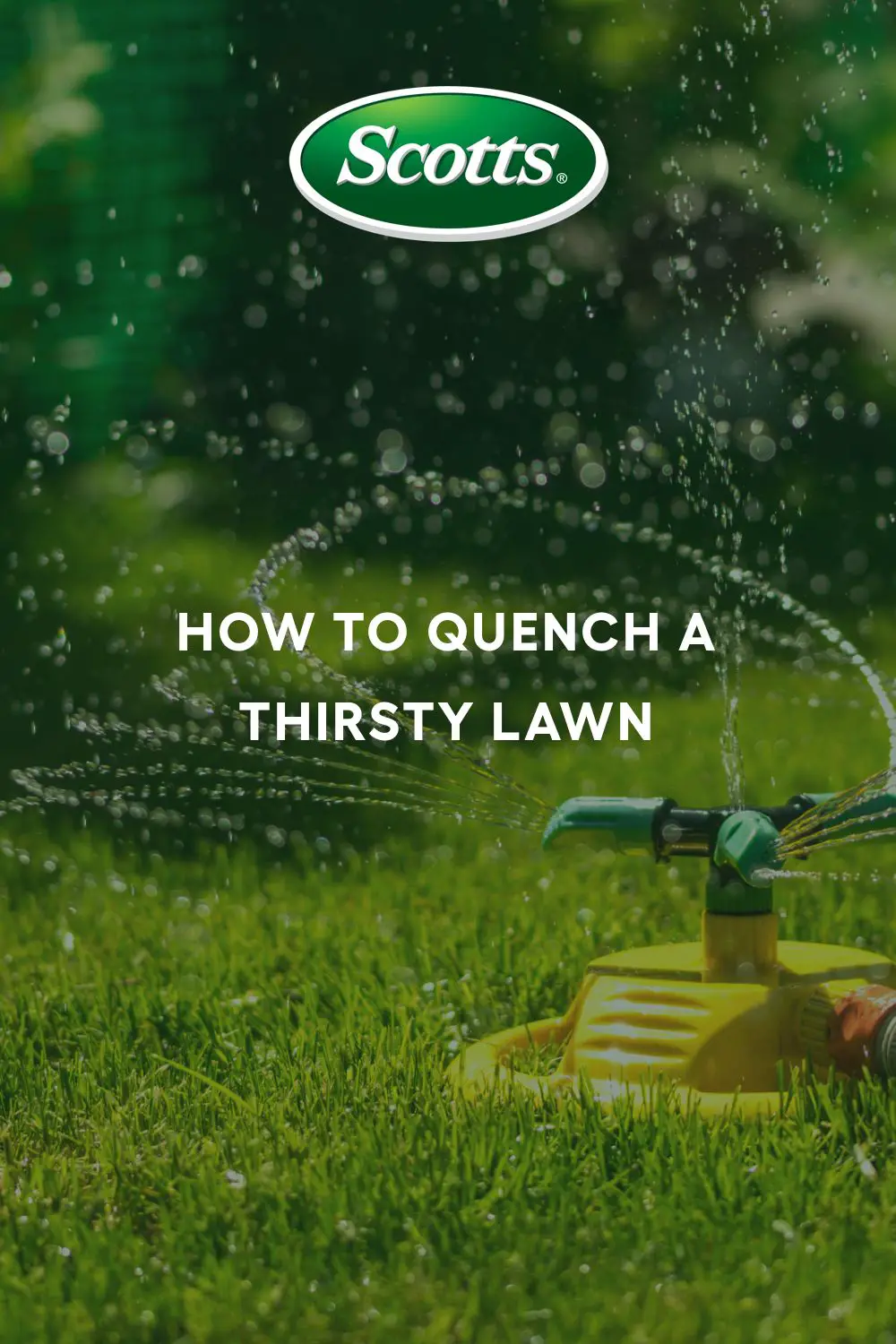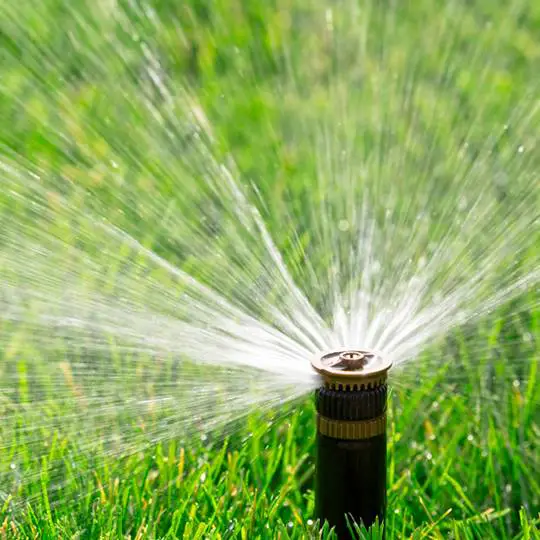Why Early Morning Watering During Hot
This time is recommended for several reasons. From dawn until midday, evaporation rate tends to be low, as it is cooler in the surroundings.
Evaporation plays a key role here as often water is lost through this process by escaping to the atmosphere from the surface of leaves.
The wind is also calmer during this time. Hence if you water the grass at this time, chances are that there will be very less wastage of water.
As a result, more water remains on the lawn and can get soaked in the soil, giving the grass roots more chance to absorb the water. Typically, the ideal time ranges from sunrise till 8 a.m.
If you cant water in the morning, then another option is to water your lawn during the late afternoon or evening hours, when the sun is past its peak time.
This is a smart idea as it will be comparatively cooler than midday and give the grass blades enough time to dry off before night comes.
All in all,
- In the morning, the best recommended time is between sunrise to 8 a.m.
- The afternoon/evening period can start from 4 to 6 p.m.
Efficient Use Of Water
- Water before 10:00 am and after 4:00 pm
- Inspect sprinkler system monthly for leaks
- Use a soil moisture sensor
- Adjust automatic timers each time there is a power outage
- Install a rain shut off device to your existing sprinkler system
- Visual signs of stress from lack of water include footprints lingering after being made and grass blades folding in half
- Place water gauges through out your yard to monitor the amount of reclaimed water that is being dispersed per zone
The Best Time Of Day To Water Your Lawn
The best time to water your lawn is early in the morning since it is cooler and the winds tend to be calmer, so the water can be absorbed by the roots before it evaporates. If for some reason you cannot water in the morning, it is best to water between 4 p.m. and 6 p.m. rather than during the day or early afternoon. During the day more than 50% of the water evaporates before entering the ground. Make sure the blades of grass dry before dark to reduce the risk of fungal disease. Watering in the evening is not recommended!
You May Like: How Much To Pay Teenager To Mow Lawn
How Much Water Do You Use When You Water Your Lawn
All lawn areas require 1- 1.5 per week.;;This is best done in one to two waterings per week depending on your soil type and if we are experiencing heat waves .;;The trick here is to water deeply so that the roots grow down deeper into the soil to chase the water, thereby leaving more soil above them to protect them during periods of dryness and excessive heat.;;
How Often Should You Water Your Lawn

Everything living requires hydration to survive, including your lawn. You need to water your lawn to keep it healthy and strong, but it can be difficult to gauge how often you should be watering it and how much water your lawn actually needs.
The weather is always changing, but weve reached a time of year where the precipitation is few and far between, so watering your lawn becomes especially important. You also want to make sure you do so efficiently, in case we run into a stretch with no rain and receive some water-use restrictions from the government.
So, to learn how frequently you should water your lawn, you need to consider several factors.
We want to ensure your lawn gets the best care possible, so if you have any other questions or concerns about how to water your lawn, our team of professionals would be happy to assist you.
We offer services to keep your lawn healthy and thriving through the summer season, so call us today to book a consultation with one of our experts and get started on your summer lawn care.
Service Areas
OFFICIAL CONTEST RULES
Read Also: What Is Pre Emergent Lawn Care
How To Tell If Your Grass Isnt Getting Enough Water
There are several tell-tale signs that you need to water your lawn. Its simple as can be, but if your once-vibrant green lawn has taken on a gray shade, you need to water. Curled grass blades are another indicatorit means your grass is thirsty.
If youre unsure, consider tackling one of two tests. For the step test, simply walk on your lawn. If your lawn is well-watered, your grass should spring right back up where youve stepped. If it doesnt, its lacking moisture, so it needs water.
The screwdriver test is another classic. See if you can drive a long-bladed screwdriver 6 inches into the soil. If you cant push the tool down that far or you meet a lot of resistance, its time to water.
How To Tell If Your Lawn Has Been Watered Enough
There are some simple tricks that will determine if a lawn is receiving enough water. First, does it look healthy? If it looks healthy, then it probably is which means stick to what you are doing. Another way to determine if your lawn needs to be watered is to submerge a screwdriver into the grass. If it easily sinks 6 to 7 inches, then your lawn is receiving an adequate amount of water each week. If not, it is probably time to make a change to your watering routine.
Be ready for changing weather and be aware of when a lawn needs more feeding and fertilizing. Give lawns an organic fertilizer and compost in fall and spring and cut back on watering when dry days turn to rainy ones.
If you see mushrooms growing in your grass, it is most likely due to overwatering. The best next step is to decrease the amount of watering until the mushrooms are gone.
You May Like: How To Keep Your Lawn Healthy
Is It Ok To Water Grass In The Sun
Regardless of whether your grass grows in sun or shade, watering during the early morning hours is best. When you water in bright, sunny weather, the water from the sprinkler can evaporate before it ever hits the ground. Your grass needs around an inch and a half of water over two watering sessions per week.
Watering Different Types Of Lawns
During the first year of your lawns growth, whether it’s a newly seeded, sodded, sprigged, or plugged lawn, don’t rely solely on Mother Nature to do the watering. Additional irrigation should always be provided.
When watering a newly seeded lawn, the key is to keep the top inch of soil consistently moist but not soggy. You will likely need to mist the seeded area once or twice a day . Once the seeds start to germinate, continue to keep the top 2 inches of soil moist until the new grass reaches a mowing height of around 3 inches. After that, begin to cut back watering to twice per week and soak the soil deeper, about 6 to 8 inches, to encourage the grass roots to grow down deep into the soil.
Also Check: Do You Need To Aerate Your Lawn
When Is The Best Time To Water Your Lawn
The best time to water lawn is in the early morning. The 2nd best time is RIGHT NOW! Watering in the morning is best because this allows the water to soak deep into the soil and allows the leaves of the grass plant to dry before the water evaporates as it gets warmer in the day. ;If you cant water in the morning, evenings are OK, just try to do it earlier! ;.
Keep These Tips In Mind When Watering A Cool
- Tall fescue has a deep root system and the highest drought tolerance of all the cool-season grass types.;
- Lawns that are a mixture of Kentucky bluegrass, perennial ryegrass, and fine fescues will go dormant during drought if not watered, but will revive when rain returns.
There are tons of ways to water your lawn, from sprinklers to smart watering solutions. Each has their own sets of benefits, so choose the solution that works best for you and your lawn. Below are a few methods to consider.
Pulsating sprinklers : These shoot water horizontally at a high velocity so the water isnt affected by wind.
Hose-end sprinklers: Great for small- to medium-size lawns. There are many different types, so you can choose the one that fits your lawn best.
In-ground sprinklers: These can deliver water in the most efficient pattern. Choose sprinklers that are low to the ground and use a horizontal spray pattern for best results.
Recommended Reading: What Is The Smallest Riding Lawn Mower
Water Deeply But Not Too Often
- Too much watering can lead to poor growing conditions and disease problems.
- Water only when your lawn needs it, usually no more than once a week when there is no rainfall.
- Apply at least 2.5 cm of water. Put a tuna or pet food can on your lawn to measure how much you’ve watered. Stop watering when it’s full.
- Consider the soil type and surface features. Grass growing on compacted, fine soil or on slopes needs lighter, more frequent watering.
Install Drip Lines And Rain Gauge

To ensure your entire yard is getting enough water, install drip irrigation lines for trees, shrubs and gardens, and install a rain gauge.;
Drip irrigation is a great way to ensure smaller plants still receive deep watering without the risk of being overwatered by a sprinkler.;
Likewise, a rain gauge will tell how much water the yard is receiving from rain and may even help you save on your water bill!
Remember to apply IFA 4-Step Fertilizer to give your grass the nutrients it needs and to mow regularly enough to keep grass blades at roughly three inches in length. As always, stop by your local IFA Country Store for more tips on how to grow a healthy lawn or to get help dealing with a troublesome lawn issue.
Don’t Miss: How To Get Rid Of Flying Ants In The Lawn
Considering The Role Of Salt In Soil And Water
In areas of the state where water is high in salts, plant a salt-tolerant grass species, such as Seashore Paspalum, bermudagrass, or Zoysia. Water deeply but only occasionally so salt does not accumulate in the soil. High levels of sodium damage soil quality and affect the ability of water to filter through the soil. Also, salt can exacerbate the effect of drought on turfgrass. Contact your county Extension agent for more information.
Seeding Or Sodding Your Lawn
Overseeding may be needed to increase the density of your lawn. A dense lawn has fewer weeds and is healthier.
Pests, extreme weather conditions and neglect can also damage lawns, even when the soil is in good condition.
If your lawn is a little thin, proper mowing, fertilizing and watering may be all it needs. If that doesnât help, overseeding with a quality lawn seed may be the answer.
Choosing your seed
Choose a grass seed high in Fescue content and low in Kentucky Blue content , remembering to use cool season varieties.
Select a seed mixture that is high in physical seed attributes, such as purity and germination, and also contains the best composition of grass for the use intended.
Soil fertility, moisture availability, sunlight levels and traffic affect the tyope of blend that will provide the best results for your yard.
Look to sow your lawn with a blend of grass seed varieties. Check our local nurseries and garden centres in Calgary for drought tolerant blends of lawn seed.
Adding seed to your lawn
Before you spread the seed over the thin areas, make sure there will be good soil-to-seed contact, and rake away any dead grass or debris.
Dethatchers, aerators or vertical mowers can also be used to prepare the lawn prior to overseeding.
Time your overseeding with a day before rain. Donât do before a hot weather forecast. The seed will need water to germinate.
Apply 900 grams per 1,000 square feet or more if the lawn is thin .
Using sod for your lawn
You May Like: Should I Water My Lawn In The Morning Or Evening
Proper Lawn Watering For A Greener Lawn In The Lehigh Valley Or Buxmont Pa
If you have more questions about watering your lawn, were here to lend an ear and help you answer those questions. At Joshua Tree, we view lawn care as a partnership between us and our clients. Were doing everything we can on our end to ensure your lawn is healthy and green but it also takes some help on your end, including proper watering.
We are always available to help make that process easier and ensure that you know what your lawn needs to thrive. Theres a lot of misinformation out there but were here to help you set the record straight.
If youd like to find out more about our;three lawn care program options;so that your lawn can receive the best possible care, contact us for a;free consultation;or give us a call at 610-365-2200;so that we can answer any questions.
Ready to get started?
Keep An Eye On The Weather
Knowing how often to water the new seed also depends on the weather. On hot and sunny days, youll need to water more often to keep the seed bed damp. Wind also dries out the lawn, so you should water more frequently on windy days as well. If its sunny, 90 degrees and windy, you should be watering at least 3 times a day. Rain is a great way to get water on new grass seed but be careful! A light rain in the morning will dry out by the afternoon. Make sure the grass seed stays damp the entire day.
Uncles Tip: In bare spots that youve seeded, make sure to cover the new seed with weed-free Sphagnum Peat Moss or Primera Field Conditioner. These seed dressings help hold the moisture on the seed and help with germination.
Also Check: What Time Of Day Is Best To Water Lawn
Watering And Types Of Soil
Soil texture changes how much moisture the soil can retain and for how long. This affects how long it takes to moisten roots, and how quickly the soils will dry out again.
Checking soil moisture with a soil moisture probe both before and after watering is the best indicator of adequate watering. Soils in Calgary are clay-based and retain more moisture than it might appear.
Amend your soils with compost to improve soil texture and health. See our free Green Cart compost pickup dates.
Increase the amount of top soil where ever possible. Having a minimum of eight inches of top soil will improve water absorption and drainage of your soil.
Visit Top Soil Calculator to determine how much soil you need for a project.
Tips For Responsibly Watering Your Lawn This Summer
There are simple ways you can save water this summer. Some of it requires a change of thinking. For example, if your region is prone to drought, you may need to give up the idea of a perfect evergreen lawn as it wont hold up in your region of the country in those extremes.
Likewise, if you have sandy soil thats unable to hold water, you should add soil amendments to make it loamier. Loamy soil is like the forest floordark, rich, and able to store water underground.
Here are those 12 tips to help you save water and keep your lawn alive:
So, add soil amendments, such as compost, to loosen up the soil and help its absorption rate. Brinlys tow-behind carts help you tote your soil amendments to your lawn for a makeover. Use our tow or push spreaders to broadcast the amendments and fertilizers throughout your yard.
Recommended Reading: How To Keep Lawn Green In Summer
How To Water To Promote Deep Roots
Grasses like our Heat Wave or Macho Mix prefer deep, infrequent watering schedules once established. Generally, this means watering heavily a couple times a week. Heavily generally means at least an inch of water per week. Watering heavily and letting the grass dry out between each watering encourages the roots to grow deeper to look for water, and deeper roots will help the plant during times of drought and heat.
Our bluegrass blends, like Blue Wave and Estate Mix, prefer more water than their fescue cousins. Mid-summer when its hot and dry anticipate watering a Blue Wave lawn a minimum of three times per week, with more frequent watering in extended periods of heat and drought.
Watering During The Summer Months

Depending on where you live, you may not need to water your lawn during the spring. The soil beneath the grass is often saturated with water from snowmelt, and spring rain will provide even more water.;
However, as temperatures rise in May and June, you should slowly start watering your lawn more thoroughly and more frequently.;
Start with watering once a week for about twenty minutes at a time, applying roughly half an inch of water to the grass.;As temperatures exceed 80 degrees, you may need to start watering every three days for thirty to forty minutes at a time, or one to two inches of water each time.
The most common turf species in Utah and the broader Intermountain West is Kentucky Bluegrass, which needs about two inches of water per week in the summer.;
Recommended Reading: How Often Should I Water My Lawn In Colorado
